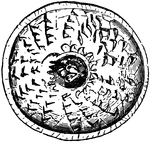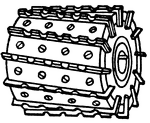
Spring-tooth Rake
The Spring-tooth Rake was often objected by farmers because the wire teeth scratched up too much earth…
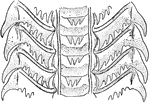
Snail
Many mollusks live upon seaweeds, and the greater number of terrestrial forms are fond of garden vegetables.…
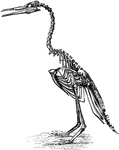
Restoration of Hesperornis regalis
"Hesperornis regalis, (a fossilized restoration) which stood about three feet high, had blunt teeth…
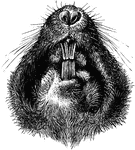
Plains Pocket Gopher
"Under Side of Head of Geomys bursarius, showing entrance of external cheek-pouches and sulcate superior…

Wild Oat Grass
Wild Oat Grass (Danthonia spicata), also referred to as White Top grass, and Old Fog grass, is common…
Wild Oat Grass
Wild Oat Grass (Danthonia spicata), also referred to as White Top grass, and Old Fog grass, is common…
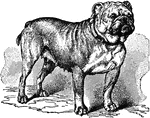
Bulldog
"Bulldog, a variety of the common dog, remarkable for its short, broad muzzle, and the projection of…
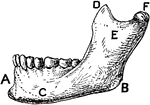
Lower Jawbone of Man
"A, symphysis menti; B, angle of jaw; C, body or horizontal ramus; D, coronoid process; E, ascending…

Falcons
"Falcons. Bill furnished with a sharp tooth and notch near the end of the cutting edge of the upper…
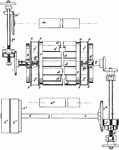
Cloth Napping Machine used for Teaseling Woolen Cloth
This gig mill uses a rotating drum head which carries a series of rotating napping roles. This machine…
Dental Floss Holder
Dental floss is either a bundle of thin nylon filaments or a plastic ribbon used to remove food and…

Three Teeth Comb
A comb is a toothed device used in hair care for straightening and cleaning hair or other fibers. Combs…
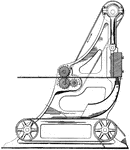
Toothpick Making Machine
This machine is used to make toothpicks. A toothpick is a small stick of wood, plastic, bamboo, metal…

Driving Gear
The driving gear is a machine component consisting of a toothed wheel attached to a rotating shaft.…

Stepping Block
A step block supported by an arm clamp also holds a work piece which has been machined. The step block…
Tooth Brush Framing
This is a late model toothbrush framing, toothbrushes are instruments which are made using a small brush…
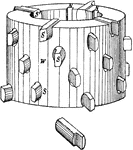
Sectional Milling Cutters with Inserted Teeth Tool
A cast iron hub with teeth inserted spirally attached to a mandrel to create a gear.

Ring Milling
"The workpiece is fastened on a round platen, which in turn is attached to the table of a large and…

Saw Set
A saw set is a device used in the sharpening of hand saws. Once the teeth have been jointed and filed,…

Lower Jaw of Megatherium Fossil Skeleton
The lower jaw and teeth of the Megatherium, elephant sized sloth. The teeth are quandrangular, or triangular…
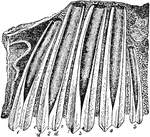
Upper Molar Teeth of Megatherium Fossil Skeleton
Illustration showing the upper molar teeth of the megatherium, a giant sloth. The teeth were 7 to 8…
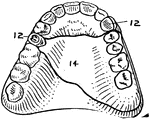
Dental Anchorage Denture
A partial or complete set of artificial teeth for either the upper or lower jaw. Also called dental…
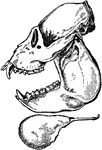
Side View of Howler Monkey
A side view of the howler monkey skull. The monkey have four sharp canines, long teeth on skull, on…

Tool Combination Rake
A long-handled implement with a row of projecting teeth at its head, used especially to gather leaves…

Hack Saw
Any similar tool or device, as a rotating disk, in which a sharp continuous edge replaces the teeth.
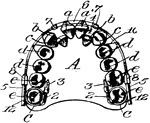
Replacement Denture
An artificial replacement of one or several of the teeth (partial denture), or all of the teeth (full…
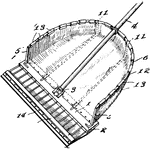
Multipurpose Rake
A long-handled tool with a row of teeth at its head; used to move leaves or loosen soil
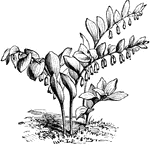
Polygonum Japonicum
A flower in the buckwheat family. A drooping flower with a white tube and green deltoid teeth.
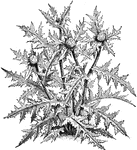
Gundelia Tourneforth
The flower heads of gundelia tourneforth are purple and large. The flowers grow in clusters at the end…

Flowering Branch of Hibbertia Perfoliata
Hibbertia perfoliata flowers are pale yellow. The flowers bloom in summer. The leaves are edged with…

Leaf of Ilex Aquifolium Crassifolia
Ilex aquifolium crassifolia is a green leaved variety of holly. The leaves are dull green. The leaves…
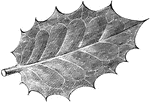
Leaf of Ilex Aquifolium Ovata
Ilex aquifolium ovata is a green leaved variety of holly. The leaves are about two and a half inches…

Seed Vessel of Lychnis
The seed vessel of lychnis burst open lengthwise. The capsule opens by as many teeth as there are styles.

Fret Saw, in use
This illustration shows a fret saw in use. The blade is a thread of metal with teeth, set in a 'U'-shaped…
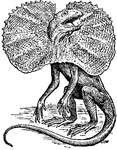
Frilled Lizard
Found in Oueensland and other parts of Australia, this lizard belongs to the family Agamidae. It reaches…
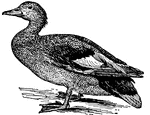
Gadwall Duck
The Gadwall (Chaulelasmus streperus) is a widely distributed duck, appearing throughout Europe and N.…

Bill of Gadwall
The bill of the Gadwall Duck, showing the comb-like 'teeth' that they are known for.

Galeopithecus
Galeopithecus is the generic name of certain mammals from the Malayan region, commonly (incorrectly)…

Helical Gearing
Helical gearing is a modification of ordinary toothed gearing in which the pitch surfaces may be cylinders…
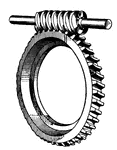
Screw-and-Worm Gearing
Screw-and-Worm gearing is a type of gearing in which the velocity ratio is independent of the radii…
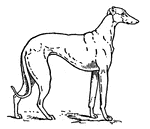
Greyhound
The Greyhound as a show dog is judged as follows: height and weight, ranging from 23 to 27 in. and from…

Carding Process in the Manufacuring of Jute
After the softening process in the manufacturing of jute, the fibers are about six feet long, and are…

Great Kangaroo
The Great Kangaroo, or 'boomer', or 'old man' (Macropus giganteus), attains a height of about five feet…
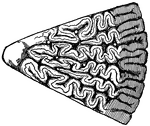
Section of Tooth of Typical Labyrinthodont
This illustration shows a section of a tooth of a typical Labyrinthodont. Labyrinthodont, or Stegocephali…

Lamium Album
Lamium album (also known as the white dead-nettle, or archangel) is a member of the Lamium, a genus…

Parable of the Marriage Feast
"But when the king came in to behold the guests, he saw there a man who had not on a wedding-garment:…
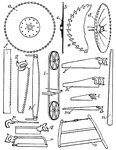
Collection of Saws
This illustration includes numerous types of saws: a. Circular saw (right-hand and left-hand saws have…
Sawfish, Side View
Pristis pectinatus. "1. An elasmobranchiate or selachian fish of the family Pristidae, having the snout…

Collection of Saw-Sets
A saw-set is an "instrument used to wrest or turn the teeth of saws alternately to the right left so…
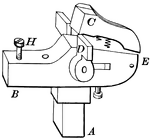
Saw Set for a Work Bench
"a. shank for fixing the implement to a bench; c. punch, hinged to a base b and e; and pressed upward…

Scalpriform, Left Lower Incisor of a Beaver
Close-up illustration of scalpriform incisor of a beaver. It is "chisel-shaped; having the character…
Sawfish, View from Underneath
Pristis pectinatus. "1. An elasmobranchiate or selachian fish of the family Pristidae, having the snout…

Dogtooth Spar
"...a variety of calcite, crystallizing in scalenohedral forms; so named from a fancied resemblance…

